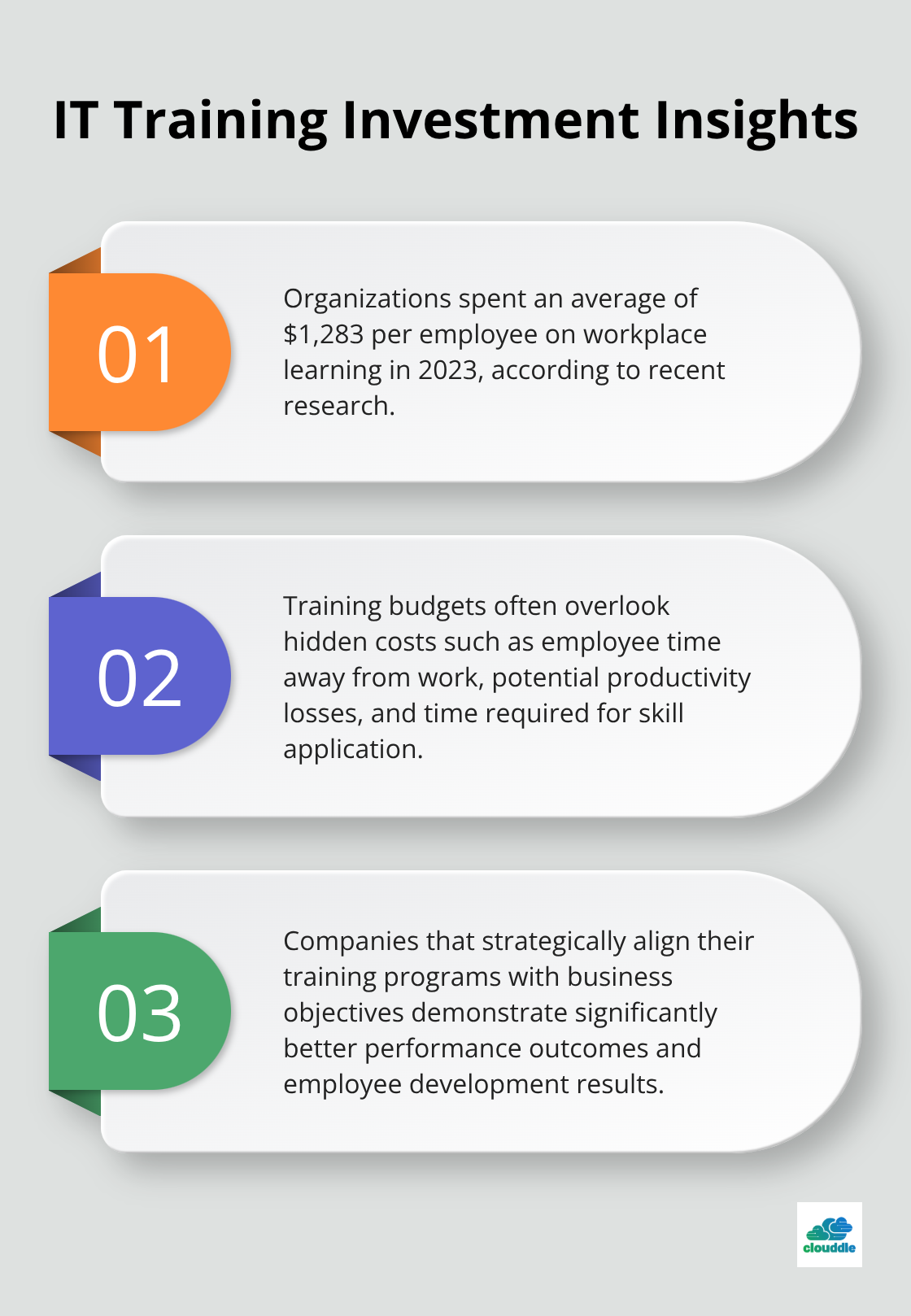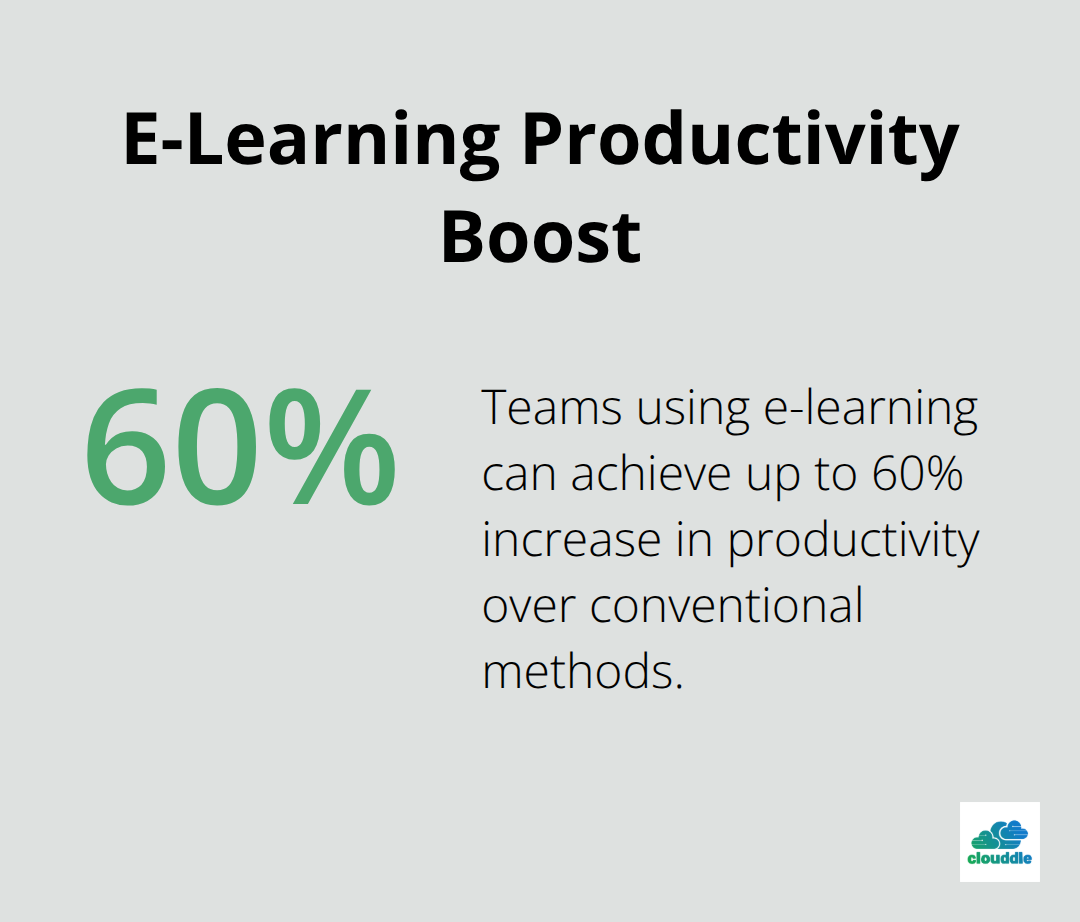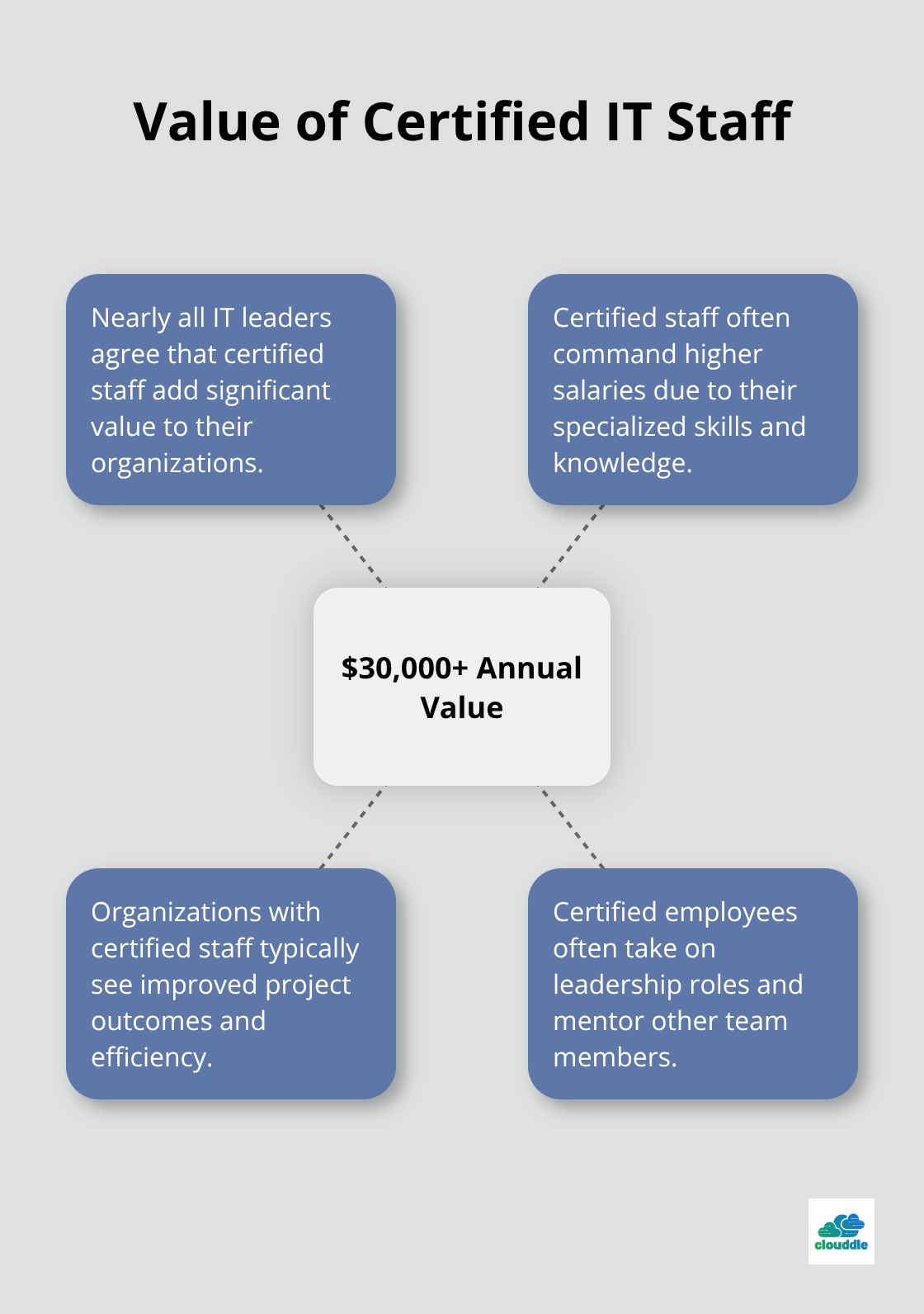Companies waste millions on ineffective IT training every year. Poor training choices lead to skill gaps, frustrated employees, and missed business opportunities.
We at Clouddle see organizations struggle with selecting the right IT training packages for their teams. The market offers hundreds of options, making the decision overwhelming for most businesses.
This guide breaks down the selection process into manageable steps, helping you choose training that delivers real results for your investment.
Assessing Your IT Training Needs
Identify Current Skill Gaps in Your Team
Most companies skip the needs assessment phase and jump straight into training package purchases. This approach leads to widespread training misalignment, as highlighted in LinkedIn’s 2021 Workplace Learning Report. Start with a comprehensive skills audit that maps current team capabilities against required competencies.
Survey your IT staff directly about their confidence levels with specific technologies. Conduct technical assessments and review recent project outcomes to identify performance gaps. Focus on skills that directly impact your business operations rather than trendy technologies that sound impressive but serve no practical purpose.
Align Training with Business Technology Strategy
Your training investment must support your organization’s technology roadmap for the next 18-24 months. Companies that strategically align their training programs with business objectives demonstrate significantly better performance outcomes and employee development results.
Examine your current technology stack, upcoming migrations, and planned system implementations. If you’re moving to cloud infrastructure, prioritize AWS or Azure certifications over legacy system training. Match training intensity to implementation timelines – critical skills need immediate attention while future requirements can follow a longer development path.
Calculate Real Training Costs and Time Investment
Training budgets typically account for direct costs but ignore the substantial opportunity cost of employee time away from productive work. The average organization spent $1,283 per employee on workplace learning in 2023, according to recent research.

Factor in salary costs during training periods, potential productivity losses, and the time required for skill application. Effective training requires substantial time investment for technical skill development, with additional hours needed for practical application. Set realistic timelines that allow for proper skill absorption without overwhelming your team. Consider spreading intensive training across multiple months rather than condensing it into short periods that reduce retention rates.
Once you understand your specific training needs and constraints, the next step involves identifying the essential features that separate effective training packages from mediocre ones.
Key Features to Look for in IT Training Packages
Effective IT training packages prioritize hands-on experience over theoretical lectures. Teams that leverage e-learning can expect a 40-60% increase in productivity compared to those relying solely on conventional methods. The best training programs dedicate at least 60% of their time to practical exercises, lab work, and real-world simulations.

Hands-On Learning and Practical Exercises
Look for packages that include sandbox environments, virtual labs, and project-based assignments that mirror actual workplace scenarios. Training that focuses heavily on PowerPoint presentations and lectures produces minimal skill transfer to job performance. Quality programs structure their curriculum around real problems that participants will face in their daily work environments.
Participants should complete actual projects during training sessions rather than watch demonstrations. The most effective programs assign capstone projects that require students to apply multiple skills simultaneously, simulating the complexity of real-world IT challenges.
Lab Access and Practice Environments
Quality training providers offer 24/7 access to practice labs and cloud environments where participants can experiment without risk to production systems. The training package should include dedicated lab time equivalent to at least double the instructor-led hours.
Participants need unrestricted access to practice environments for weeks after formal training ends, not just during scheduled class times. The best providers maintain these environments for 30-90 days post-completion, giving learners time to reinforce their skills.
Industry Certifications and Recognized Credentials
Focus on certifications that employers actively seek and pay premiums for in your specific market. Avoid training packages that offer internal certifications or credentials that lack industry recognition.
The training should include exam vouchers, practice tests, and guaranteed retake opportunities. Verify that instructors hold current versions of the certifications they teach and maintain active industry experience (not just academic backgrounds).
Ongoing Support and Resources
The most valuable training packages provide ongoing mentorship and support channels after formal instruction ends. Look for programs that offer dedicated Slack channels, monthly office hours with instructors, and access to updated course materials for at least six months. Training effectiveness drops significantly without continued support during the critical skill application period following course completion.
Support systems should include peer networks where graduates can collaborate on challenges and share solutions. This community aspect often proves more valuable than the initial training content itself.
With these essential features identified, you need to evaluate how different training providers stack up against each other in terms of cost, quality, and outcomes.
Comparing Different IT Training Providers
Training providers fall into distinct categories with vastly different value propositions and success rates. Traditional classroom providers like Global Knowledge and New Horizons offer hands-on virtual and in-person modern IT & Technology training for team optimization and career development. Online platforms such as Pluralsight and LinkedIn Learning offer affordable access at $300-$500 annually but lack hands-on practice and personalized support. Bootcamp-style providers like General Assembly command $10,000-$15,000 for intensive programs with job placement guarantees, while cloud vendor programs from AWS, Microsoft, and Google provide specialized technical depth at moderate costs of $1,500-$3,000 per certification track.
Instructor Quality Determines Success
The instructor makes or breaks any IT program regardless of curriculum quality. Effective instructors combine current industry experience with proven ability to teach, not just academic credentials or vendor certifications. Look for instructors who actively work on real projects, maintain GitHub repositories, and contribute to open-source communities. Avoid programs that staff career trainers who lack recent hands-on experience with the technologies they teach.
The best instructors share war stories from actual implementations, troubleshoot problems in real-time during labs, and adapt their methods based on class progress. Verify instructor backgrounds through LinkedIn profiles and professional references rather than rely on promotional materials.
Success Metrics Reveal Provider Effectiveness
Legitimate providers publish detailed success metrics that include certification pass rates, job placement statistics, and salary improvement data. Nearly all IT leaders agree that certified staff add value to their organizations, with most saying in excess of $30,000 a year. Be suspicious of providers that refuse to share success data or only offer vague testimonials.

Student reviews on platforms like Course Report and Reddit provide unfiltered feedback about actual experiences, curriculum quality, and post-training support. Focus on recent reviews that mention specific technologies and outcomes rather than generic praise.
Cost Analysis Beyond Sticker Price
Compare total program costs that include hidden fees, materials, exam vouchers, and lab access charges. Many providers advertise low base prices but add substantial costs for essential components like practice environments and certification attempts (which can cost $300-$500 per exam).
Calculate the cost per hour of actual instruction versus self-study time. Some programs pad their duration with excessive reading assignments and videos to justify higher prices. Factor in opportunity costs of employee time away from productive work when evaluating different options.
Verification Through Direct Graduate Contact
Contact recent graduates directly through LinkedIn to verify claims about career advancement and skill application in real work environments. Ask specific questions about job placement assistance, salary increases, and how well the program prepared them for certification exams and actual job responsibilities.
Final Thoughts
The right IT training packages require systematic evaluation of your team’s skill gaps, business technology requirements, and budget constraints. The most effective programs combine hands-on practice environments, industry-recognized certifications, and ongoing instructor support rather than theoretical presentations. Quality instructors with current industry experience outweigh flashy marketing materials and low prices that hide additional costs for essential components like lab access and exam vouchers.
Focus on providers who demonstrate measurable success through certification pass rates, job placement statistics, and verifiable graduate outcomes. Your final decision should align training intensity with implementation timelines while accounting for the full cost of employee time away from productive work. Contact recent graduates directly to verify claims about career advancement and practical skill application in real workplace scenarios.
We at Clouddle support organizations throughout their digital transformation journey with comprehensive technology solutions. Schedule skills assessments within the next two weeks, then compare three providers using the criteria outlined above. This structured approach transforms overwhelming training decisions into manageable business investments that deliver measurable results for your organization.


